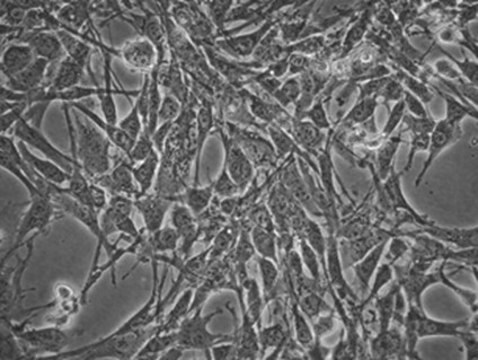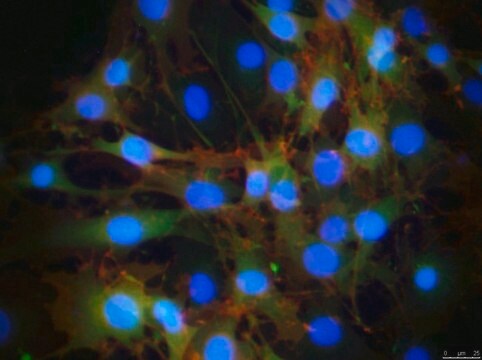SCC167
MS5-hDLL1 Stromal Cell Line
The MS5-mDLL1 stromal cell line is used in a serum-free artificial thymic organoid (ATO) system to generate mature T-cells from human hematopoietic stem and progenitor cells.
Synonyme(s) :
MS-5-hDLL1
Se connecterpour consulter vos tarifs contractuels et ceux de votre entreprise/organisme
About This Item
Code UNSPSC :
41106514
eCl@ss :
32011203
Produits recommandés
Source biologique
mouse
Technique(s)
cell based assay: suitable
cell culture | mammalian: suitable
Conditions d'expédition
ambient
Catégories apparentées
Description générale
In vivo, T-cells develop in the thymus from bone-marrow derived hematopoietic stem and progenitor cells (HSPCs). In vitro, various model systems have been employed to mimic thymic function supportive of T-cell development including the OP9-DL1 system. Recently, a serum-free artificial thymic organoid (ATO) system was developed that supports highly efficient and reproducible in vitro differentiation and positive selection of human T-cells from multiple sources of HSPCs, including cord blood, bone marrow and peripheral blood CD34+ HSPCs (Seet et al. 2017). A key component of the ATO system is the MS5-hDLL1 cell line which obviates the need for primary thymic tissues.
To generate the MS5-hDLL1, a murine stromal cell line (MS5) was transduced with a third-generation lentiviral vector encoding human DLL1 and eGFP (Seet et al. 2017). The highest 5% GFP-expressing cells were FACS-sorted and expanded.
To form organoids, MS5-hDLL1 stromal cells are aggregated with HSPCs by centrifugation and cultured on a cell culture insert at the air-fluid interface. Detailed protocols for setting up the artificial thymic organoid (ATO) system are described in reference (Seet et al. 2017).
Reference:
Seet, C.S., He, C., Bethune, M.T., Li, S., Chick, B., Gschweng, E.H., Zhu, Y., Kim, K., Kohn, D.B., Baltimore, D. and Crooks, G.M. (2017) Generation of mature T cells from human hematopoietic stem and progenitor cells in artificial thymic organoids. Nat Methods 14(5): 521-530.
To form organoids, MS5-hDLL1 stromal cells are aggregated with HSPCs by centrifugation and cultured on a cell culture insert at the air-fluid interface. Detailed protocols for setting up the artificial thymic organoid (ATO) system are described in reference (Seet et al. 2017).
Reference:
Seet, C.S., He, C., Bethune, M.T., Li, S., Chick, B., Gschweng, E.H., Zhu, Y., Kim, K., Kohn, D.B., Baltimore, D. and Crooks, G.M. (2017) Generation of mature T cells from human hematopoietic stem and progenitor cells in artificial thymic organoids. Nat Methods 14(5): 521-530.
Description de la lignée cellulaire
Stromal Cells
Application
Research Category
Immune Response
Inflammation & Immunology
Immune Response
Inflammation & Immunology
The MS5-mDLL1 stromal cell line is used in a serum-free artificial thymic organoid (ATO) system to generate mature T-cells from human hematopoietic stem and progenitor cells.
This product is intended for sale and sold solely to academic institutions for internal academic research use per the terms of the “Academic Use Agreement” as detailed in the product documentation. For information regarding any other use, please contact licensing@emdmillipore.com.
Qualité
• Each vial contains ≥1X10⁶ viable cells.
• Cells are tested negative for infectious diseases by a Mouse Essential CLEAR panel by Charles River Animal Diagnostic Services.
• Cells are verified to be of mouse origin and negative for inter-species contamination from rat, chinese hamster, Golden Syrian hamster, human and non-human primate (NHP) as assessed by a Contamination Clear panel by Charles River Animal Diagnostic Services.
• Cells are negative for mycoplasma contamination.
• Cells are tested negative for infectious diseases by a Mouse Essential CLEAR panel by Charles River Animal Diagnostic Services.
• Cells are verified to be of mouse origin and negative for inter-species contamination from rat, chinese hamster, Golden Syrian hamster, human and non-human primate (NHP) as assessed by a Contamination Clear panel by Charles River Animal Diagnostic Services.
• Cells are negative for mycoplasma contamination.
Stockage et stabilité
Store in liquid nitrogen. The cells can be cultured for at least 10 passages after initial thawing without significantly affecting the cell marker expression and functionality.
Clause de non-responsabilité
This product contains genetically modified organisms (GMO). Within the EU GMOs are regulated by Directives 2001/18/EC and 2009/41/EC of the European Parliament and of the Council and their national implementation in the member States respectively. This legislation obliges {HCompany} to request certain information about you and the establishment where the GMOs are being handled. Click here for Enduser Declaration (EUD) Form.
Unless otherwise stated in our catalog or other company documentation accompanying the product(s), our products are intended for research use only and are not to be used for any other purpose, which includes but is not limited to, unauthorized commercial uses, in vitro diagnostic uses, ex vivo or in vivo therapeutic uses or any type of consumption or application to humans or animals.
Unless otherwise stated in our catalog or other company documentation accompanying the product(s), our products are intended for research use only and are not to be used for any other purpose, which includes but is not limited to, unauthorized commercial uses, in vitro diagnostic uses, ex vivo or in vivo therapeutic uses or any type of consumption or application to humans or animals.
Code de la classe de stockage
12 - Non Combustible Liquids
Classe de danger pour l'eau (WGK)
WGK 1
Point d'éclair (°F)
does not flash
Point d'éclair (°C)
does not flash
Certificats d'analyse (COA)
Recherchez un Certificats d'analyse (COA) en saisissant le numéro de lot du produit. Les numéros de lot figurent sur l'étiquette du produit après les mots "Lot" ou "Batch".
Déjà en possession de ce produit ?
Retrouvez la documentation relative aux produits que vous avez récemment achetés dans la Bibliothèque de documents.
Notre équipe de scientifiques dispose d'une expérience dans tous les secteurs de la recherche, notamment en sciences de la vie, science des matériaux, synthèse chimique, chromatographie, analyse et dans de nombreux autres domaines..
Contacter notre Service technique




